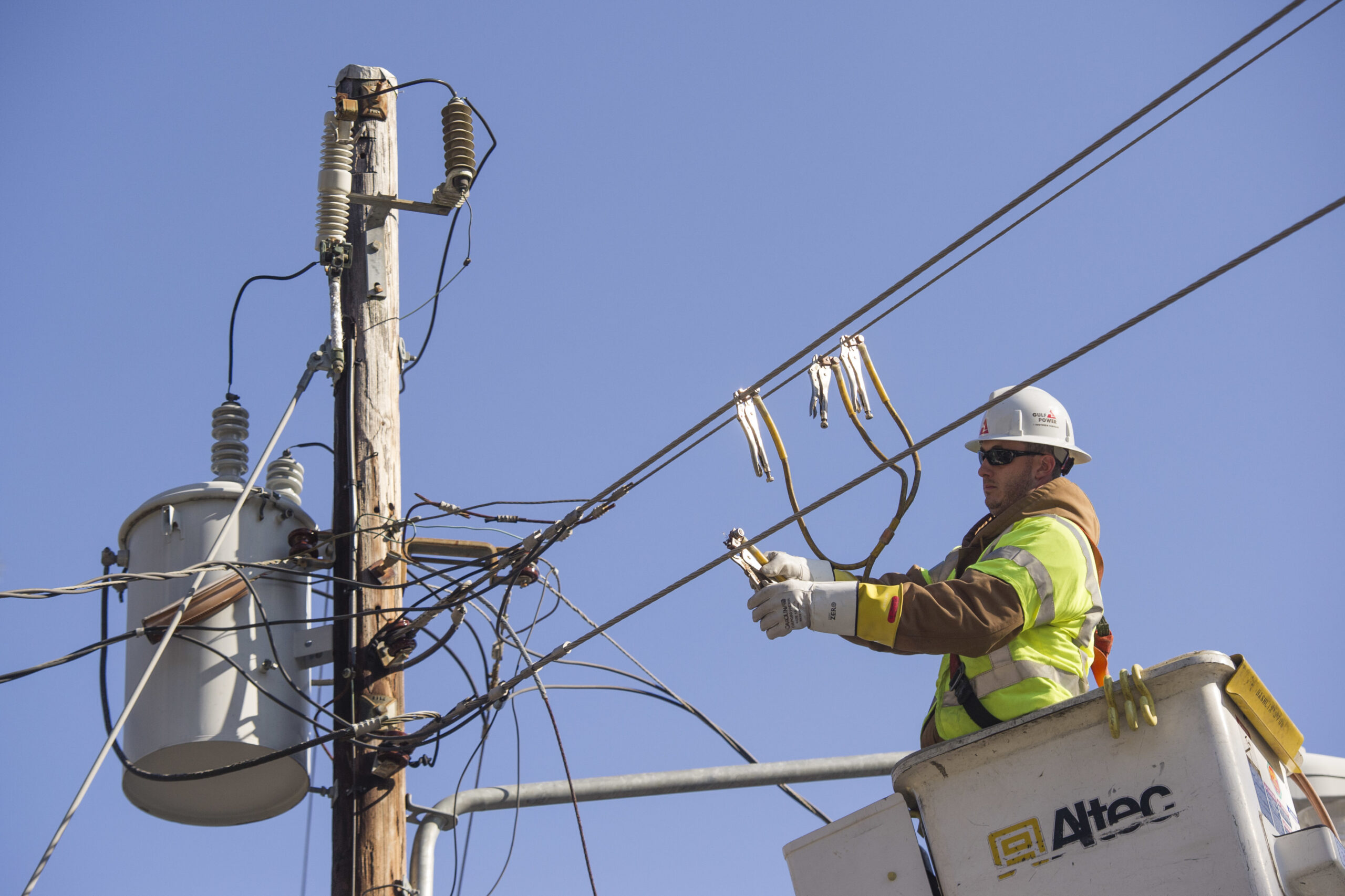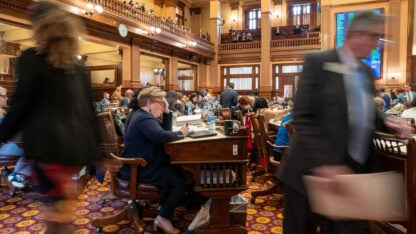This coverage is made possible through a partnership between WABE and Grist, a nonprofit environmental media organization..
Georgia is enjoying an economic boom. Lured by tax breaks, high-tech data centers and manufacturers are flooding the state. It’s a trend that state leaders are celebrating at every opportunity.
“We have seen over 171,000 new jobs come to our communities; we brought in over $74.5 billion of investment to the state,” Governor Brian Kemp told a gathering of lawmakers, business leaders and other Georgia bigwigs earlier this year.
But that growth has created a problem — all the new businesses need lots of electricity.
The state’s largest electric utility, Georgia Power, now says it needs significantly more energy, and provided significantly sooner than planned to meet the spike in demand.
In response, the company asked state regulators to sign off on a plan to buy and generate that electricity. However, the plan, which calls for solar power coupled with battery storage, relies heavily on fossil fuels. This includes three brand new turbines to be powered with oil and natural gas.
Customers and clean energy advocates alike decried the original plan. Large groups of students and medical professionals dominated the public comment sections of hearings on Georgia Power’s request, pleading with the state’s Public Service Commission to reject it.
“Fossil fuels kill. They kill our ecosystems, they kill our people, and more importantly, fossil fuels will kill our future generations,” Emory University student Dakota Tauteeq told the commissioners.
Despite opposition from public commenters, environmental advocates and other interest groups, including the Department of Defense, the commission approved a deal to build the new gas turbines. The deal also included construction of electricity from other utilities – much of which is expected to be generated with fossil fuels – and add the proposed batteries.
“Approval of this agreement will preserve and protect the reliability and quality of electric service our customers expect and supports the continued economic development of our state,” said Aaron Abramovitz, chief financial officer of Georgia Power, in a statement.
A version of this is playing out all over the country, because for the first time in years, power demand is growing.
Electricity-hungry data centers are popping up to serve everything from digital medical records to artificial intelligence and cryptocurrency.
Federal policies that favor U.S.-made versions of electric vehicles, solar panels and other technology are bringing manufacturing back stateside. In addition, concerns about fossil fuels are motivating people to switch to electric cars and appliances.
All that is testing the heart of the Biden administration’s climate policy: making it cheaper and more attractive for utilities to use renewable energy instead of climate-warming fossil fuels.
The Inflation Reduction Act, passed in 2022, includes $125 billion in tax credits for electric companies that choose wind, solar and battery storage. The idea is that incentives will tip the scales, so when a utility needs to make energy it will choose renewables over fossil fuels.
“It’s this great big pool of money, this game changing piece of legislation for them, with millions and millions of dollars that they can take advantage of,” said Sierra Club analyst Noah Ver Beek.
But it’s not clear that utilities are taking full advantage of that giant pool of money. Like Georgia Power, many utilities still want to expand fossil fuel plants, or build new ones.
Ver Beek and his colleagues studied the energy plans of 50 utilities that have been submitted or updated since the law passed. They found that about a third failed to include the new clean energy provisions in their models, while many failed to account for the full potential of the incentives.
For instance, many didn’t consider the additional incentives the IRA offers for locating projects in what the federal government calls “energy communities,” places where there has either been fossil fuel extraction, or where power plants that run on coal or natural gas have been located.
“That, for one, is just a lack of ambition on the utilities,” Ver Beek said. “If you can get an extra 10% off the cost of your project, that’s a lot of money that is being left on the table.”
A spokesperson for the industry trade group Edison Electric Institute said it’s too early to say utilities aren’t taking full advantage of the law.
Georgia Power does plan to use the new tax credits but officials with the company say natural gas is still the most reliable option to meet the current surge in demand. Other utilities across the country are making similar choices.
That’s because the tax credits are running up against the nationwide jump in energy demand. Faced with so much demand, Bank of America utilities analyst Julien Dumoulin-Smith said utilities are falling back on their old standby: fossil fuels.
“What we’re seeing is a growing trend to go back to gas plants, mostly to effectively backstop the grid,” he said.
The idea, he said, is not to run new gas plants all the time, but to turn them on for limited periods when demand for energy is highest — think, when it’s very hot or very cold, so people start cranking their air conditioning or heaters.
This concept is known as a “peaker plant,” and it reflects how utilities plan. They base their plans not on the typical amount of power being used most of the time but on those highest peak hours. That way, the utilities can guarantee they’ll have enough power without resorting to blackouts.
Many utilities consider fossil fuel plants to be the only reliable way to meet demand peaks because they can be turned on quickly to immediately meet the need, said Shelley Robbins, who works on the Phase Out Peakers project for the nonprofit Clean Energy Group.
But that’s not true anymore, she said.
“The good news is there are now alternatives.”
Those other options are a bit more complicated than flipping the on/off switch at a power plant. According to Robbins, they require utilities to run the grid more creatively, instead of solely making power and sending it out to meet demand.
For instance, electric companies can reward people for using less energy during those hours of peak demand. They can improve power lines so they can carry more electricity. Utilities can help property owners install solar panels with battery backup, then draw on all those batteries when they need extra power.
Various utilities around the country have tried all these methods and proven they can work, according to Robbins and proponents of those solutions who testified before the Georgia PSC.
Robbins noted, however, that the regulators who approve utility plans and the lawmakers who set state energy policies are used to turning to experts when they make decisions about complex issues like this — and the experts they trust are still largely in the fossil fuel industry.
“That voice is still there, that is still speaking to legislators and to utility regulators, and you know, whispering in their ear, that fossil is the only solution and it simply is not true,” she said.
Robbins says regulators, lawmakers and utilities need education about these alternatives — and the fact that they’re now reliable solutions for climbing energy demand.
The fate of U.S. climate policy and planet-warming emissions depends on making this shift.









